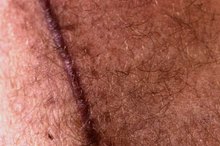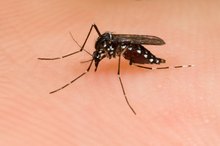How to Get Rid of Purple Scars
Scarring of the skin occurs after a deep wound has healed or after improper healing of lesions such as acne and boils. Scars take on different colors due to pigmentation gathering in the area. Purple is one of those colors that can affect acne, boil and burn scars 2. Although the best treatment for purple scars is prevention, according to DERMAdoctor's website, treating scars that have already formed is possible 2. It is important to consult your physician when scars do not respond to treatment or continue to grow after your wound has healed.
Eat plenty of vitamin C-enriched foods such as broccoli and citrus fruits, suggests "The Doctors Book of Home Remedies." Vitamin C promotes collagen reformation around the blood vessels, speeding up the skin's healing process.
How to Remove Scars Left From Boils
Learn More
Apply an over-the-counter scar cream to your scars. According to DERMAdoctor, scar creams contain vitamins A and C to help form collagen to promote healing of scar tissue 2. As the skin heals, discoloration fades and scars become less noticeable with regular use.
Massage your scar with a daily moisturizer for up to five minutes, to keep the skin supple and nourished. According to "The Doctors Book of Home Remedies," massaging will increase circulation to the scar, increasing collagen production for improved healing 1. The moisturizer is good for your skin by keeping it hydrated and helping speed up the healing process.
How to Get Rid of Scars on Legs by Razors
Learn More
Apply a silicone-based gel or silicone sheeting to large purple scars, suggests DERMAdoctor 2. Silicone helps flatten and fade discolored scars, especially those that are larger than the original wound. These scars are known as keloids.
Consume foods high in zinc to speed up healing and promote healthy skin, suggests "The Doctors Book of Home Remedies." Zinc-enriched foods include pumpkin seeds, lean beef, brazil nuts and Swiss cheese.
Related Articles
References
- Mother Nature: Doctors Book of Home Remedies--Scarring
- DERMAdoctor: Acne Scars
- Fabbrocini, G, Annunziata, MC, D'Arco, V, et al. Acne scars: pathogenesis, classification and treatment. Dermatol Res Pract. 2010;2010:893080. doi:10.1155/2010/893080
- Kravvas G, Al-niaimi F. A systematic review of treatments for acne scarring. Part 1: Non-energy-based techniques. Scars Burn Heal. 2017;3:2059513117695312. doi:10.1177/2059513117695312
- Gozali MV, Zhou B. Effective treatments of atrophic acne scars. J Clin Aesthet Dermatol. 2015;8(5):33-40.
- Wollina U, Goldman A. Fillers for the improvement in acne scars. Clin Cosmet Investig Dermatol. 2015;8:493-9. doi:10.2147/CCID.S86478
- Kravvas G, Al-niaimi F. A systematic review of treatments for acne scarring. Part 2: Energy-based techniques. Scars Burn Heal. 2018;4:2059513118793420. doi:10.1177/2059513118793420
- Ogawa R. Keloid and hypertrophic scars are the result of chronic inflammation in the reticular dermis. Int J Mol Sci. 2017;18(3). doi:10.3390/ijms18030606
- Rabello FB, Souza CD, Farina júnior JA. Update on hypertrophic scar treatment. Clinics (Sao Paulo). 2014;69(8):565-73. doi:10.6061/clinics/2014(08)11
- França K, Keri J. Psychosocial impact of acne and postinflammatory hyperpigmentation. An Bras Dermatol. 2017;92(4):505-509. doi:10.1590/abd1806-4841.20175645
- Tosti, A, De Padova, MP, Beer, KR, eds. Acne Scars: Classification and Treatment. London: Informa UK Ltd.; 2010.
Writer Bio
Sharin Griffin has been a freelance writer since 2009, specializing in health-related articles. She has worked in the health-care industry as a certified nursing assistant and medical technician. Griffin's medical expertise encompasses bariatrics and geriatric care, with an emphasis on general medicine. She is completing an associate degree in health-care administration from Axia University.









